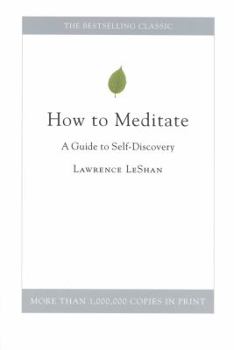How to Meditate: A Guide to Self-Discovery
Select Format
Select Condition 
Book Overview
Lawrence LeShan's classic guide to meditation introduced mindfulness to an entire generation. Now it's available in a new paperback edition. Since its initial publication nearly 50 years ago, this... This description may be from another edition of this product.
Format:Paperback
Language:English
ISBN:0316880620
ISBN13:9780316880626
Release Date:September 1999
Publisher:Little Brown and Company
Length:240 Pages
Weight:0.45 lbs.
Dimensions:0.7" x 5.0" x 7.4"
Customer Reviews
4 ratings
A gem of a book
Published by Thriftbooks.com User , 19 years ago
I bought this book in order to have a basic yet comprehensive guide to mediation. I had dabbled a little in the practice over the years and knew the basic breath-counting/mantra technique. But I was looking for additional guidance, having already picked up (and discarded) the "Idiot's Guide to Meditation." For me, that book and others like it spend too much time on details of chakras, postures, and energies. I wanted something broader, something that concentrated on the internal, spiritual aspects of meditation rather than on the specifics of different traditions. All religions have their own schools of meditation, and I wanted commonalities, not New Age cliches. I found what I wanted it in this book.Leshan, a trained psychotherapist, and researcher presents a concise, comforting, and comprehensive guide to the subject. He's very eclectic in his approach--his sources include Christian mystics, Zen Buddhists, and Hindu yogis. He points out what they all have in common, takes what's useful from each traditiona, and distills them into something that's workable for a beginner. He dispels many of the myths that surround meditation-as-fad in our society and stresses the role of individual discipline. He suggests the general outlines of programs, but leaves the actual choices up to you. The only problem that I had with this book is probably related to its original date of publication--1973. Back then, meditation was still a "way-out" hippie practice that most people looked upon with suspicion. As a result, Leshan goes to considerable lengths to justify the practice for skeptical Westerners. He does a good job with this, but nowadays those parts of his book are less necessary. Nonetheless, this book retains its value as a classic guide to meditation. For me, at least, it's a keeper.
The Place To Start For Beginners
Published by Thriftbooks.com User , 22 years ago
I stumbled across this little book in the 1970's and have been recommending and sending it to friends, relatives, and acquaintances ever since. It is what it is: an introduction to meditation for beginners and the curious. It is simple, straight-forward, practical, unpretentious, and easy to read and comprehend. Therefore, it is the perfect starter book. It offers an introduction to a variety of meditative techniques but, rather than advocating any of them, urges readers to experiment with the different techniques until what is most comfortable and/or productive for them. After reading it and determining a favored technique, the reader can move on to something heavier. One of the things I have always liked about LeShan is the fact that, in this book, he acknowledges some of the more (potentially) startling by-products or side-effects of meditation but does not emphasize them. This may be a disadvantage as well as an advantage, but this is an introduction to some meditative techniques, not an encyclopedia of meditative practices.Anyone interested in exploring meditation should have this book and give it a try. Since it was written there has been considerable research into the benefits of anti-stress practices. The medical community is beginning to catch onto the non-intrusive, non-addictive, non-injurious benefits of meditation as an antidote to stress. Perhaps you should, too. With this book and some practice you can learn to take a chill instead of a pill. And if it does not offer enough for you, at least it provides some direction to finding out what will be.Read the book. Practice the techniques for a month or two. The benefits from the breathing exercises alone, if you honestly and consistently apply them, will lead you to extoll the virtues of this little, big book that is still influential more than twenty-five years after it was first published.
FINE EXPLORATION OF MEDITATION FORMS & STYLES
Published by Thriftbooks.com User , 24 years ago
LeShan wrote How to Meditate years before the hundreds of popular books presenting easier, more simplistic approaches to meditation. And being a scientist himself, LeShan was compelled to stick to a more clinical, validated -- and thorough -- approach. How to Meditate is an excellent volume for those who've been meditating for a period of time and are interested in expanding into different forms of meditation. LeShan provides sufficient background and helpful lessons for each form. Take note that his approach is not touchy-feely and his writing is borderline austere. This is a slim, but informative book you can refer back to year after year.
The best basic training manual on meditation written.
Published by Thriftbooks.com User , 24 years ago
Although Lawrence LeShan has degrees from three universities, he writes with a simple, completely straightforward style. The first section is on the benefits of meditation. And the next section describes how to do four different kinds of meditations.If you are interested in meditation and you want the author to get right down to business, this is your book. LeShan says what he has to say in 137 pages. I'm the author of the book, Self-Help Stuff That Works, and I'm an expert on what works and what doesn't. Meditation works, and LeShan's instructions are effective and practical. I highly recommend this book.





